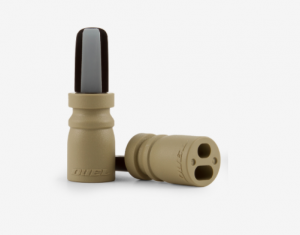Elk Season is Here!
And you know what that means, time to start thinking about elk calls! Calls are an essential part of any avid elk hunter’s gear. Hunters that use calls can be usually be divided into two categories. Those in the first group sit silently and motionless, hidden from sight until a game animal wanders or flies into view. This method captures plenty of game, but some hunters prefer a more hands-on approach. This group of hunters also try to stay hidden, but they make plenty of noise to mimic animal movement. In either case, success depends on producing a convincing enough reproduction of an animal’s calls to convince a game animal to come to them.
Bull elks produce a loud vocalization consisting of screams known as “bugles”, which can be heard for miles. Bugling is often viewed as an adaptation to open environments such as parklands, meadows, and savannas, tundras, due to the fact that sound can travel great distances. Females are attracted to the males that bugle more often and have the loudest call. So the louder and more persistently you can use your call, the better chance you have of attracting game. It is also extremely important to decide what types of elk calls you plan on using during your hunt. There are several different kinds of calls, and each is suited to a specific purpose.
 Bugle Tubes: Bugle Tubes are an essential part of any successful elk hunt. These calls mimic the bugles of bull elks, and can be used to attract either cows or bulls. Most bugle tubes contain a baffle that allows the hunter to dial back the volume of their call to simulate a bull that is moving farther and farther away. This is an excellent strategy for attracting other bulls to your location.
Bugle Tubes: Bugle Tubes are an essential part of any successful elk hunt. These calls mimic the bugles of bull elks, and can be used to attract either cows or bulls. Most bugle tubes contain a baffle that allows the hunter to dial back the volume of their call to simulate a bull that is moving farther and farther away. This is an excellent strategy for attracting other bulls to your location.
 Open Reeds: Open reed calls are typically used to mimic the sound cows and calfs, but are extremely versatile as they can also produce bull bugles if need be. Open reeds are the perfect partner for a bugle horn, as they allow hunters to simulate a wide variety vocalizations and calls.
Open Reeds: Open reed calls are typically used to mimic the sound cows and calfs, but are extremely versatile as they can also produce bull bugles if need be. Open reeds are the perfect partner for a bugle horn, as they allow hunters to simulate a wide variety vocalizations and calls.
 Bite Calls: Another great addition to your call collection would be a bite call. These elk calls produce a high-pitch, nasally sound that you’ll have a hard time making with an open reed or bugle horn. The sounds created by these types of call may be the last little trigger that you need to make the bull come that last 50 yards.
Bite Calls: Another great addition to your call collection would be a bite call. These elk calls produce a high-pitch, nasally sound that you’ll have a hard time making with an open reed or bugle horn. The sounds created by these types of call may be the last little trigger that you need to make the bull come that last 50 yards.
However, when it comes down to it, you can’t just buy a call, head to the woods and start making noise and expect game to come rushing out of the brush. Like any activity, becoming a competent caller takes education, practice, and patience. Whether you’re calling turkeys, waterfowl, deer, or elk, each call demands the appropriate calling technique, and the only way to learn is to first hear what the call should sounds like, how much to call, and where and when to call. Good Luck and happy hunting!
For more information about elk hunting check out our new Elk Hunting in Colorado pages!






